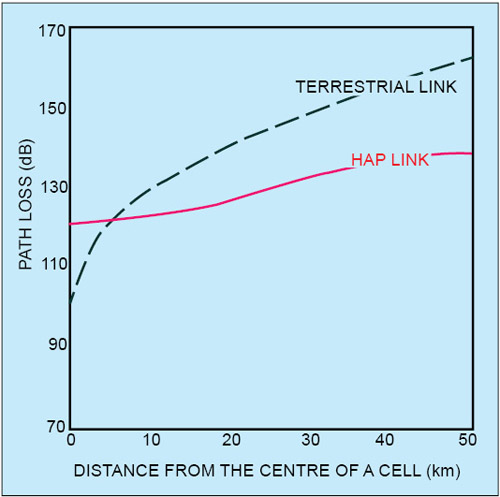Smart antenna technology can play a key role in broadband communication using HAP for high-speed vehicles like trains and helicopters. In smart antenna technology the antenna radiates a directive beam towards the subscriber based on the direction of arrival and the time of arrival of the signal coming from the subscriber. Signal processing part of the antenna system performs this job.
Smart antenna technology increases the efficiency of radio resource management. Due to wind, the displacement of HAP can be both in horizontal and vertical directions. In this situation, angular variation can be used to determine whether fixed or phased array antennae are required to achieve a given link budget in HAP communication.
The beam width of a receiving antenna may vary from two degrees to 20 degrees. Typical HAP antenna gain is 22-25 dBi, whereas typical gain of a train antenna is 17 dBi.
Diversity techniques using two or more antennae may be useful for vehicular applications where space is not a constraint.
Modulation and coding
For good network capacity and highest spectral efficiency, suitable modulation and coding schemes are required in broadband communication using HAP. Application-based adaptive techniques may provide better communication with specified quality of service and bit-error rate. Quadrature amplitude modulation, Quadrature phase-shift keying and Gaussian minimum-shift keying are recommended modulation techniques for HAP communication. Powerful forward-error correction (FEC) code may be useful when channel conditions are poor to maintain the communication link. Also, codes like convolutional code, turbo code and Reed-Solomon code can be used for better performance.
Research challenges in HAP-based broadband communication
Broadband wireless communication using HAP is a relatively new technology in the area of communications. One big task for the researchers is development of a suitably-shaped HAP that is light-weight and provides wide coverage. The HAP structure should use renewable energy efficiently. Efficient channel assignment and resource allocation schemes need to be developed for HAP communication.

Another research problem is modeling of HAP channel, where three cases are to be considered: first is the line-of-sight, second is the shadowing (by trees and/or small obstacles) and third is the full blockage of signal (by large obstacles like mountains and big buildings).
Since HAP communication uses wide frequency bandwidth, frequency band-wise studies of propagation and losses at high altitudes are important research topics. These studies must include both LOS and NLOS environments. Proper management and planning are necessary for integration of HAP technology with terrestrial and satellite infrastructures.
Development of traffic management algorithm is another issue. The feasibility of communication of inter-platform links at high altitude is to be investigated. Research on adaptive-based modulation, coding and networking is necessary for HAP communication. Design and development of directive antennae with a high gain is necessary, especially for HAP communication with small-size and low-profile terminals.
To sum up
HAP can be a very important technology for 4G wireless communication. Broadband wireless communication using HAP is effective for many purposes including disaster management, communications in rugged terrains, monitoring of sports events (motor cycling, car racing, cycle racing, etc), certain military purposes and time-limited additional support to existing communication. Broadband wireless access through HAP may be used to provide broadband Internet access and broadband multimedia services in high-speed trains. In this case, Doppler frequency shift plays an important role in HAP communication. HAPs can also be used for applications like remote sensing, navigation and surveillance.
The difficulties with HAP communication are efficient monitoring of stations, high-end antenna technology and airship manufacturing. However, there are some hurdles to overcome. For instance, it is difficult to maintain the position of the airships (HAPs), above a fixed position on the ground, by producing high power using renewable sources.
The author is a professor at the School of Electronics Engineering, KIIT University, Bhubaneswar, Odisha







